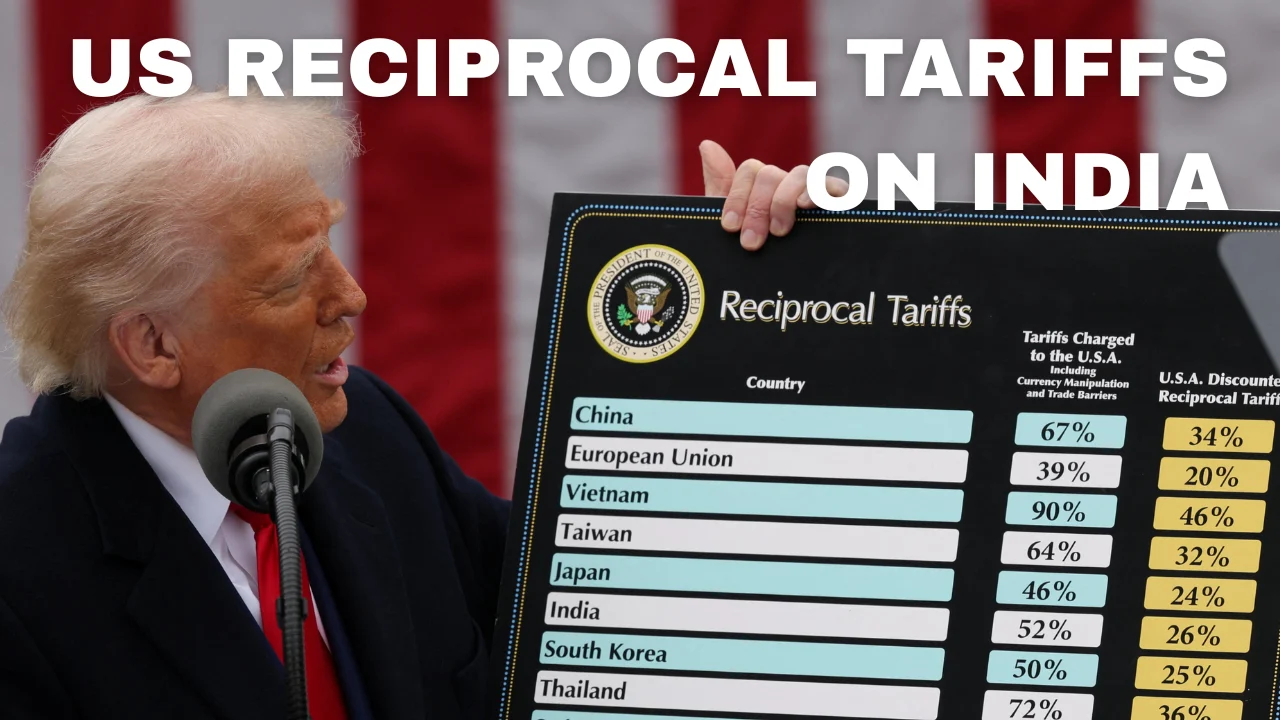US Reciprocal Tariffs on India
The US, under President Donald Trump, announced on April 2, 2025, a 27% reciprocal tariff on all Indian goods, effective April 9, as part of a policy to match tariffs India imposes on US goods. This move, highlighted during Trump’s “Liberation Day” address, aims to address the $46 billion US trade deficit with India. Sectors like automobiles (e.g., Tata Motors, Sona Comstar), IT services, pharmaceuticals, chemicals, metals, jewelry, and agriculture are hit hard, with potential annual export losses estimated at $7 billion. This could weaken the Indian rupee, deter foreign direct investment (FDI), and pressure stock markets due to disrupted supply chains.
Interestingly, global rating agencies like S&P and Fitch suggest India’s economy might be insulated, projecting a 6.5% GDP growth for 2025-26, thanks to low US market exposure. However, sectors like steel and chemicals could face indirect effects from trade redirection, adding complexity to the situation.
India’s Response and Future Outlook
India isn’t taking this lying down. The government is considering cutting tariffs on 55% of US imports worth $23 billion, affecting items like gems, jewelry, pharmaceuticals, auto parts, almonds, and quinoa, to protect its $66 billion exports to the US. Tariffs on meat, maize, wheat, and dairy (30%-60%) are non-negotiable for now, but phased cuts for automobiles (effectively over 100%) are on the table. In Parliament, Minister Jitin Prasada confirmed plans for a Bilateral Trade Agreement to boost market access and reduce barriers, focusing on increasing trade and easing non-tariff barriers.
Looking ahead, this could escalate into a trade war if tensions rise, reshaping global supply chains with countries like Indonesia, Israel, and Vietnam potentially benefiting. For Indian businesses, especially small firms, this is a major challenge, but domestic stimulus might offset some risks. It’s a wait-and-see game, with 2025 potentially redefining US-India trade relations.

Detailed Analysis: US Reciprocal Tariffs on India in 2025
This report provides an in-depth examination of the US reciprocal tariffs imposed on India, announced on April 2, 2025, and effective from April 9, 2025, under President Donald Trump’s administration. The analysis covers the background, impacted sectors, economic implications, India’s response, and future outlook, aiming to offer a comprehensive understanding for readers interested in global trade dynamics.
Background: Understanding Reciprocal Tariffs
Reciprocal tariffs are a policy where the US imposes tariffs on imports from countries at a rate matching the tariffs those countries levy on US exports. This approach, part of Trump’s “America First” trade strategy, was hinted at in February 2025 and formalized in early April. India, with an average tariff of 12% on US goods compared to the US’s 2.2% trade-weighted tariff (per WTO data), has been a focal point. The US trade deficit with India stands at $46 billion, prompting this retaliatory measure. The announcement, made during Trump’s “Liberation Day” address, set a 27% tariff on all Indian goods, alongside additional tariffs like 25% on imported automobiles and auto parts (cars/light trucks effective April 2, auto parts effective May 3).
This policy isn’t isolated to India; China faces 34%, and the EU 20%, reflecting a broader push for trade balance. The context is critical, as India-US trade relations have been tense, with historical tariff disparities fueling the current escalation.
Impacted Sectors and Economic Effects
The 27% tariff hits several key Indian export sectors, with significant economic ramifications. Below is a detailed breakdown:
| Sector | Impact Details | Estimated Effect |
|---|---|---|
| Automobiles | Companies like Tata Motors (Jaguar Land Rover) and Sona Comstar saw stock drops (5% and 4%, respectively). | Potential revenue decline, supply chain disruptions. |
| Pharmaceuticals | Major export market, exempt from reciprocal tariffs but at risk due to overall tariff environment. | Could face revenue declines, estimated at part of $11 billion exports. |
| IT Services | Significant export sector, potential tariffs on services could disrupt revenues. | Uncertain, but substantial impact possible. |
| Chemicals and Metals | At risk from trade redirection, as per S&P Global Ratings. | Disruption in steel and chemical sectors. |
| Jewelry and Agriculture | High exposure to US market, facing larger tariffs on farm products. | Potential export losses, part of $7 billion estimate. |
The economic impact is estimated at up to $7 billion annually in lost exports, according to Citi Research. This could weaken the Indian rupee, deter FDI, and pressure stock markets due to retaliatory measures and disrupted supply chains. However, global rating agencies like S&P and Fitch offer a nuanced view. S&P’s report from March 20, 2025, suggests India’s low US exposure (exports account for just over 10% of GDP) reduces tariff risks, with most rated firms able to withstand temporary earnings slowdowns. Fitch maintains a 6.5% GDP growth projection for 2025-26, warning of risks from “more aggressive-than-expected” US trade policies but noting overall resilience.
An unexpected detail is the potential for trade redirection, where other countries like Indonesia, Israel, and Vietnam could benefit as alternative suppliers, reshaping global supply chains. This adds a layer of complexity, as India’s economy might see indirect effects beyond direct tariff impacts.
India’s Response: Tariff Cuts and Diplomatic Efforts
India is actively countering the tariffs, with plans to cut tariffs on 55% of US imports worth $23 billion to mitigate the impact on its $66 billion exports to the US. According to a Reuters report from March 25, 2025, these cuts, ranging from 5% to 30%, may be “substantially” lowered or scrapped, depending on securing relief from Trump’s tariffs. The focus is on items like gems, jewelry, pharmaceuticals, auto parts, almonds, pistachio, oatmeal, and quinoa, while tariffs on meat, maize, wheat, and dairy (30%-60%) remain non-negotiable. For automobiles, where tariffs are effectively over 100%, phased cuts are sought.
Sectoral adjustments and product-by-product negotiations are underway, with wider tariff reform in early stages. In a written reply to the Lok Sabha on March 11, 2025, Minister of State for Commerce and Industry Jitin Prasada confirmed plans for a mutually beneficial Bilateral Trade Agreement, focusing on increasing market access, reducing import duties, and enhancing supply chain integration. This diplomatic effort aims to ease tensions and boost two-way trade, with discussions ongoing to mitigate the tariff impact.
Future Outlook: Potential for Trade War and Long-Term Implications
The future of US-India trade relations hangs in the balance. The tariff imposition could escalate into a trade war if both sides adopt retaliatory measures, disrupting global trade flows. For Indian businesses, especially small firms, this is a major challenge, with stock market pressure and potential currency depreciation (INR) adding to concerns. Domestic stimulus could offset some risks, but the short-term impact on revenues and supply chains is undeniable.
Long-term, this could reshape global supply chains, with alternative suppliers like Indonesia, Israel, and Vietnam gaining ground. India’s robust economic growth (projected at 6.5% GDP) and low US exposure might limit the overall impact, but sectors like steel and chemicals face disruption from trade redirection. The ongoing negotiations for a Bilateral Trade Agreement offer hope for de-escalation, but 2025 might be a pivotal year for redefining trade ties, potentially altering the global economic landscape.
Visual Representation
For a visual context, consider the image of US President Donald Trump and Indian PM Narendra Modi discussing trade policies, captured during their February 13, 2025, meeting at the White House. This image, with alt text “US President Donald Trump and Indian PM Narendra Modi discussing trade policies,” symbolizes the diplomatic efforts amidst tariff tensions.
This detailed analysis underscores the complexity of the issue, balancing economic impacts, diplomatic responses, and future uncertainties, ensuring readers have a thorough understanding of the US reciprocal tariffs on India in 2025.






